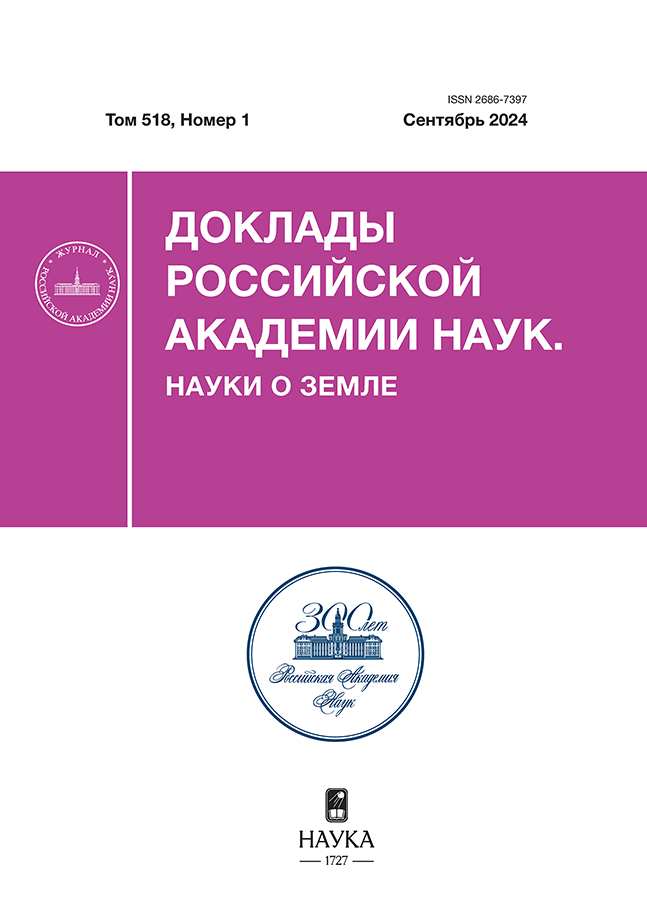Kharbey amphibolite-gneiss complex (Polar Ural): P-T evolution and results of U-Pb LA-ICP-MS isotopic studies of metamorphic zircon
- Authors: Ulyasheva N.S.1, Schujski A.S.1, Khubanov V.B.2
-
Affiliations:
- N.P. Yushkin Institute of Geology Federal Research Center, Komi Scientific Center of the Urals Branch of the Russian Academy of Sciences
- N.L. Dobretsov Geological Institute, Siberian Branch, Russian Academy of Sciences
- Issue: Vol 518, No 1 (2024)
- Pages: 97-107
- Section: PETROLOGY
- Submitted: 31.01.2025
- Published: 29.11.2024
- URL: https://rjmseer.com/2686-7397/article/view/649928
- DOI: https://doi.org/10.31857/S2686739724090103
- ID: 649928
Cite item
Abstract
The study of the Khanmeykhoy Formation of the central zone of the Kharbey amphibolite-gneiss complex showed that the amphibolites, shales and plagiogneisses common here form two primary igneous series: low-alumina tholeiitic metabasalts of normal alkalinity and a differentiated series of high-alumina rocks from metatrachybasalts to metarhyolites with high alkalinity. According to the zoning of garnets, progressive and regressive branches of metamorphism are recorded, the peak conditions of which, according to calculations using the winTWQ program, correspond to the high-temperature stage of the amphibolite facies at high pressures (T – 690–750°C, P – 8.1–9.4 kbar). For the first time, metamorphic zircon from Grt-Bi plagiogneiss with low Th/U ratios of 0.01–0.04 and weakly expressed positive cerium (Ce/Ce* = 1.4–1.7) and negative europium (Eu/Eu* = 0.7–0.9) has been identified in the anomalies, the age of which, according to the results of the U-Pb LA-ICP-MS isotope method, is estimated to be Early Carboniferous (359–341 Ma). This time apparently characterizes the transition from the peak of metamorphism to the regressive stage associated with the exhumation of rocks. The results obtained indicate the formation of the Kharbey amphibolite-gneiss complex during the formation of the Ural orogen and allow us to consider it as an indicator of Paleozoic collision processes.
About the authors
N. S. Ulyasheva
N.P. Yushkin Institute of Geology Federal Research Center, Komi Scientific Center of the Urals Branch of the Russian Academy of Sciences
Author for correspondence.
Email: nataliaulyashewa@yandex.ru
Russian Federation, Syktyvkar
A. S. Schujski
N.P. Yushkin Institute of Geology Federal Research Center, Komi Scientific Center of the Urals Branch of the Russian Academy of Sciences
Email: nataliaulyashewa@yandex.ru
Russian Federation, Syktyvkar
V. B. Khubanov
N.L. Dobretsov Geological Institute, Siberian Branch, Russian Academy of Sciences
Email: nataliaulyashewa@yandex.ru
Russian Federation, Ulan-Ude
References
- Балашов Ю. А., Скублов С. Г. Контрастность геохимии магматических и вторичных цирконов // Геохимия. 2011. № 6. С. 622–633.
- Великославинский С. Д., Глебовицикий В. А., Крылов Д. П. Разделение силикатных осадочных и магматических пород по содержанию петрогенных элементов с помощью дискриминантного анализа // ДАН. 2013. Т. 453. № 3. С. 310–313.
- Зылёва Л. И., Коновалов А. Л., Казак А. П., Жданов А. В. и др. Государственная геологическая карта Российской Федерации. Масштаб 1:1 000000 (третье поколение). Серия Западно-Сибирская. Лист Q-42. Салехард. Объяснительная записка. СПб.: ВСЕГЕИ, 2014. 396 с.
- Иванов К. С. Оценка палеоскоростей субдукции и коллизии в происхождении Урала // ДАН. 2001. Т. 377. № 2. С. 231–234.
- Каулина Т. В. Образование и преобразование циркона в полиметаморфических комплексах. Апатиты: Изд-во КНЦ РАН, 2010. 144 с.
- Краснобаев А. А. Циркон как индикатор геологических процессов. М.: Наука, 1986. 152 с.
- Лю И., Перчук А. Л., Арискин А. А. Высокобарный метаморфизм в перидотитовом кумулате комплекса Марун-Кеу, Полярный Урал // Петрология. 2019. № 2. С. 136–157.
- Пучков В. Н. Палеогеодинамика Южного и Среднего Урала. Уфа: ГИЛЕМ, 2000. 146 с.
- Пыстина Ю. И., Пыстин А. М. Цирконовая летопись уральского докембрия. Екатеринбург: УрО РАН, 2002. 168 с.
- Стратиграфические схемы Урала (докембрий, палеозой). Екатеринбург: Уралгеолком, 1993. 152 с.
- Уляшева Н. С. Геохимия амфиболитов харбейского раннепротерозойского метаморфического комплекса // Труды Карельского научного центра РАН. № 10. 2020. С. 1–11. https://doi.org/10.17076/geo1266
- Уляшева Н. С. Высокобарический метаморфизм в харбейском метаморфическом комплексе (Полярный Урал) // Вестник геонаук. 2023. № 6. С. 3–10. https://doi.org/10.19110/geov.2023.6.1
- Уляшева Н. С., Серов П.А, Травин А.В. Sm/Nd- и 40Ar/39Ar-изотопно-геохронологические исследования амфиболитов ханмейхойской свиты харбейского метаморфического комплекса (Полярный Урал) // Доклады РАН. Науки о земле. 2022. Т. 506. № 2. С. 194–201. https://doi.org/10.31857/S2686739722601016
- Berman R. G. Thermobarometry using multi-equilibribrium calculations: a new technique, with petrological applications // Can. Mineral. 1991. V. 29. Р. 833–856.
- Glodny J., Pease V., Austreim H., et al. Rb-Sr record of fluid-rock interaction in eclogites: The Marun-Keu complex, Polar Urals, Russia // Geochimica et Cosmochimica Acta. 2003. V. 67. P. 4353–4371.
- Glodny J., Pease V., Montero P., Austrheim H., Rusin A.I. Protolith ages of eclogites, Marum-Keu Complex, Polar Urals, Russia: implications for the pre- and early Uralian evolution of the northern European continental margin. In: Gee D.G., Pease V. (Eds.), The Neoproterozoic Timanide Orogen of Eastern Baltica. London: Geological Soc. (Memoirs), 2004. 30. P. 87–105.
- Jensen L. S. A new cation plot for classifying subalkaline volcanic rocks: Ontario Geol. Survey, Misc. Paper 66, 1976. 22 p.
- Meng F., Fan Y., Schmelev V. R. Constraints of eclogites from the Marun-Keu metamorphic complex on the tectonic history of the Polar Urals (Russia) // Journal of Asian Earth Sciences. 2020. V. 187. 104087.
- Rubatto D. Zircon trace element geochemistry: partitioning with garnet and the link between U–Pb ages and metamorphism // Chemical Geology. 2002. V. 184. P. 123–138.
- Sun S. S., McDonough W. F. Chemical and isotopic systematics of oceanic basalts: implications for mantle composition and processes / Magmatism in the oceanic basins. Eds. A. D. Saunders, M. J. Norry. Geol. Soc. Spec. Publ. 1989. № 42. P. 313–345.
Supplementary files










